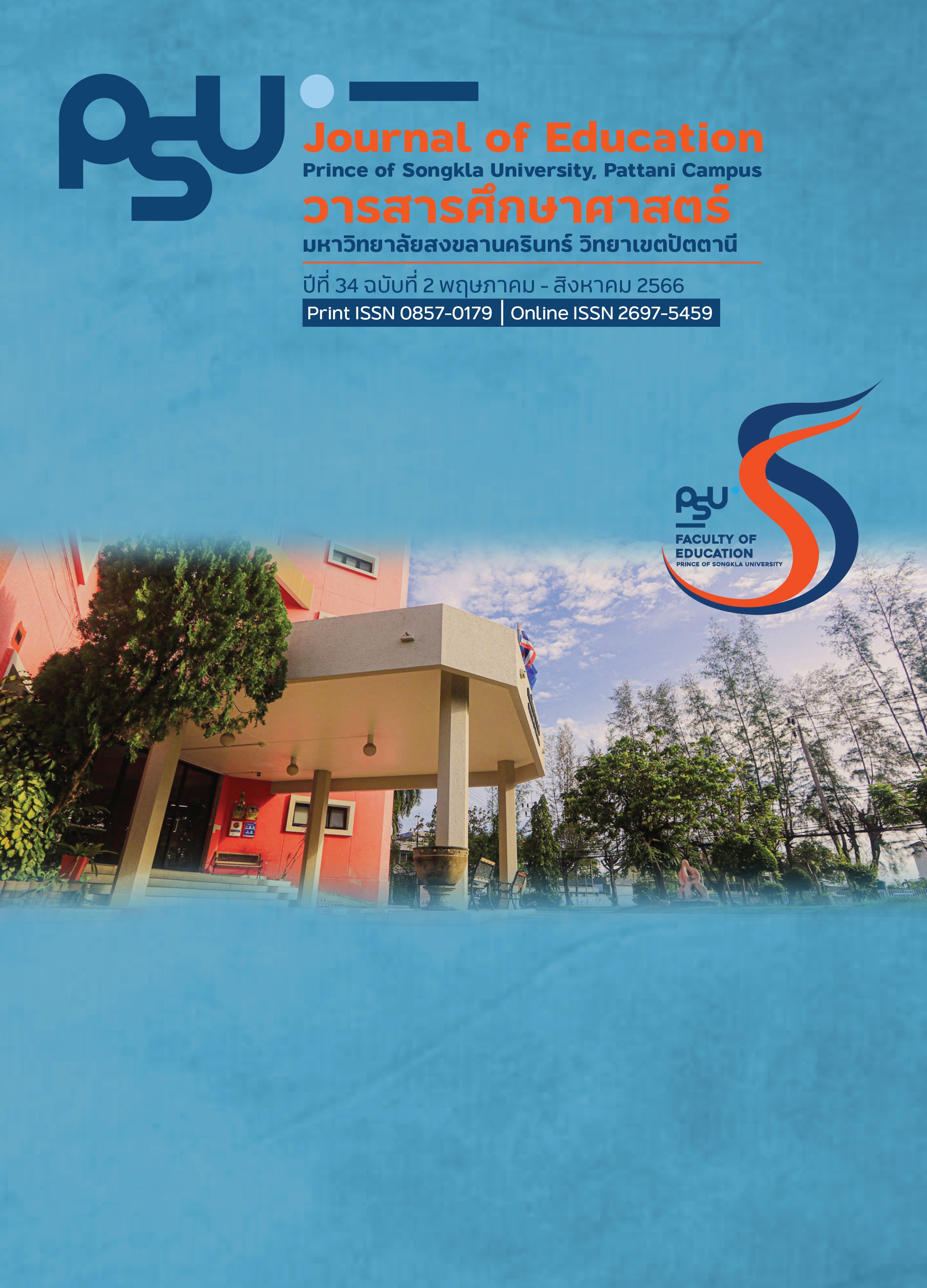การศึกษาแนวคิดเรื่องลักษณะทางวัฒนธรรมเพื่อการเรียนรู้ภาษาอังกฤษของนักศึกษาครู: การเรียนรู้ภาษาอังกฤษในฐานะภาษาต่างประเทศในบริบทประเทศไทย
Main Article Content
บทคัดย่อ
การวิจัยนี้เป็นงานวิจัยผสมวิธี มีวัตถุประสงค์เพื่อศึกษาแนวคิดเรื่องลักษณะทางวัฒนธรรมเพื่อการเรียนรู้ภาษาอังกฤษในฐานะภาษาต่างประเทศ (EFL) ในบริบทประเทศไทยของนักศึกษาครู เครื่องมือสำหรับเก็บข้อมูล
ประกอบด้วยแบบสอบถามและแบบสัมภาษณ์กึ่งโครงสร้าง กลุ่มเป้าหมาย ได้แก่ นักศึกษาครูสาขาวิชาภาษาอังกฤษ
มหาวิทยาลัยราชภัฏเลย จำนวน 30 คน การวิเคราะห์ข้อมูลเชิงปริมาณใช้วิธีการทางสถิติ และการวิเคราะห์ข้อมูลเชิงคุณภาพใช้วิธีการวิเคราะห์แก่นสาระและการตีความ ผลการศึกษาพบว่า 1) ในภาพรวม กลุ่มเป้าหมายมีแนวคิดว่าวัฒนธรรมมี 2 มิติ คือ วัฒนธรรมที่มองเห็นได้และมองไม่เห็น มีเนื้อหาความรู้ 2 ชนิด คือความรู้เชิงอัตวิสัยและวัตถุวิสัย แต่ลักษณะเด่นคือเป็นความรู้เชิงอัตวิสัยที่เปลี่ยนแปลงยากและมีความเป็นไปได้ที่จะเรียนรู้ด้วยวิธีการสอนอย่างชัดแจ้งมากกว่าการเรียนรู้แบบซึมซับหรือเรียนรู้ด้วยตนเอง 2) ด้านบทบาทของวัฒนธรรมในการเรียนรู้ภาษา
อังกฤษนั้นพบว่านักศึกษาเห็นด้วยในระดับปานกลาง ( = 3.17, S.D. = 0.56) ในประเด็นที่ว่าการเรียนรู้วัฒนธรรมมิได้เป็นเป้าหมายหลัก แก่นสาระหลัก หรือขอบเขตความรู้พื้นฐานในการเรียนรู้ภาษา มีสถานะเป็นเพียงความรู้เพิ่มเติมซึ่งเป็นทางเลือกหนึ่งของเนื้อหาการเรียนภาษา และเป็นเพียงชิ้นข้อมูลที่ถ่ายทอดผ่านภาษาเท่านั้น อย่างไรก็ตาม กลุ่มเป้าหมายมิได้ปฏิเสธอิทธิพลของวัฒนธรรมที่มีต่อแนวทางปฏิบัติด้านสังคมวัฒนธรรม ความรู้เกี่ยวกับวัฒนธรรมเป็นผลลัพธ์ที่สะท้อนให้เห็นได้จากระดับความรู้ความสามารถทางภาษา และมีแนวโน้มที่จะเสริมสร้างทักษะภาษาให้สูงขึ้นได้ ดังนั้น แนวคิดเรื่องลักษณะทางวัฒนธรรมเพื่อการเรียน EFL ในบริบทประเทศไทยของกลุ่มเป้าหมายจึงเกี่ยวข้องกับทัศนะของชุมชน เช่น การรับรู้ ค่านิยม ทัศนคติ ความเชื่อ และการมองโลก มากกว่าผลผลิตทางวัฒนธรรม
และแนวปฏิบัติทางสังคม และเป็นเนื้อหาทางเลือกในการเรียนรู้
Article Details

อนุญาตภายใต้เงื่อนไข Creative Commons Attribution-NonCommercial 4.0 International License.
เอกสารอ้างอิง
Agar, M. (1994). Language shock: understanding the culture of conversation. New York: William Morrow.
Barrett, M., Byram, M., Lázár, I., Mompoint-Gaillard, P. & Philippou, S. (2014). Developing intercultural competence through education. Pestalozzi Series No. 3. Strasbourg, Council of Europe Publishing.
Bennett, J., Bennett, M., & Allen, W. (2003). Developing intercultural competence in the language classroom. In Lange, D. and Paige, M. (Eds.), Culture as the core perspectives on culture in second language learning (pp.237-270). Greenwich, CT: Information Age Publishing.
Byram, M. (1989). Cultural studies in foreign language education. Cle vedon: Multilingual Matters Ltd.
Jhaiyanuntana, A. & Nomnian, S. (2020). Intercultural communication challenges and strategies for the Thai undergraduate hotel interns. PASAA, 59, 204-235.
Kachru, B. B. (1985). Standards, codification and sociolinguistic realism: The English language in the Outer Circle. In Quirk, R. and Widdowson, H. (Eds.), English in the world, teaching and learning the language and literatures (pp. 11-30). Cambridge: Cambridge university press.
Kramsch, C. (1993). Context and culture in language teaching. Oxford: Oxford University Press.
Kramsch, C. (1998). Language and culture. Oxford: Oxford University Press.
Labtic, I. & Teo, A. (2020). The presentation of sources of culture in English textbooks in Thai context. English Language Teaching, 13(5), 15-24.
Liddicoat, A.J., Papademetre, L., Scarino, A. & Kohler, M. (2003). Report on intercultural language learning. Canberra ACT: Commonwealth of Australia
Loo, D. B., Trakulkasemsuk, W., & Jimarkon Zilli, P. (2019). Positioning students in the international intercultural classroom: an exploration of English teachers’ discourse. Journal of Liberal Arts, Thammasat University, 19(1), 107-139.
Ministry of Education. (2008). The basic education core curriculum BE 2551 (AD 2008). Bangkok, Thailand: Ministry of Education. [in Thai]
Mitchell, R., & Myles, F. (2004). Second language learning theories (2nd ed.). London: Hodder Arnold.
Moran, P. R. (2001). Teaching culture: perspectives in practice. Canada: Heinle & Heinle.
Peterson, B. (2004). Cultural intelligence: A guide to working with people from othe r cultures. Yarmouth, Me: Intercultural Press.
Phongsirikul, M., & Thongrin, S. (2019). Developing Intercultural Awareness in ELT: Students’ Attitudes toward their Intercultural Learning Experience. REFLections, 26(1), 78–114. https://so05.tci-thaijo.org/index.php/reflections/article/view/203947
Phumpho, R. & Nomnian, S. (2019). Challenges for Thai business people using English in ASEAN. Kasetsart Journal of Social Sciences, 40, 743-750.
Risager, K. (2012). Linguaculture, in Chapelle, C.A. ed. Encyclopiedia of Applied Linguistics, Oxford: Blackwell/Wiley.
Saemee, K., & Ra, J. J. (2021). Teacher’s perceptions of cultural content in English language text-books used in multicultural classrooms at a Thai primary school. Austrian Journal of South-East Asian Studies, 14(2), 227-241
Tomalin, B., & Stempleski, S. (1993). Cultural awareness. Oxford: Oxford University Press.
Ulla, M.B. (2019). Western-published ELT textbooks: teacher perceptions and use in Thai classrooms. The Journal of Asia TEFL, 16(3), 970-977.
Weaver, G. (1993). Understanding and coping with cross-cultural adjustment stress. In R.M. Paige (Ed.), Education for the intercultural experience (pp.137-168). Yarmouth, ME: Intercultural Press.


